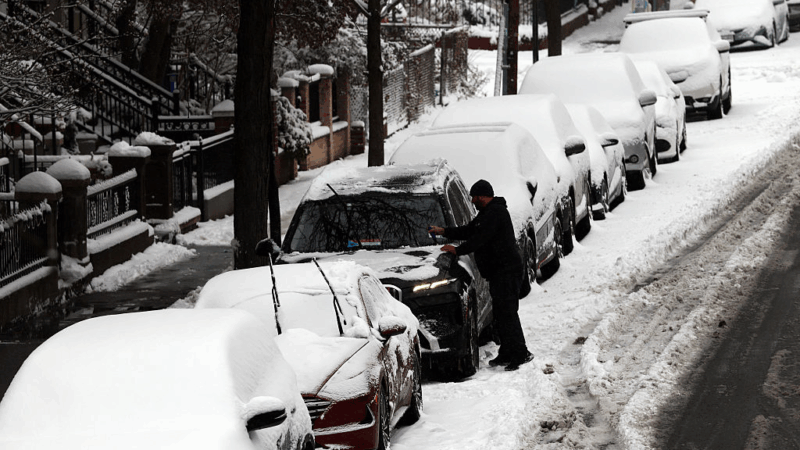Grassroots motorsport pulls big tractors and bigger crowds
LANGFORD, N.Y. — For two days in August, this small hamlet south of Buffalo becomes a can’t-miss destination for fans of a distinctively agricultural motorsport: the tractor pull.
Spectators gather on wooden bleachers flanking a long dirt runway, forming an arena that seats 4,000 people — more than the surrounding area’s total population.

“Everybody looks and waits for this first weekend [of August] to come to Langford,” says Richard Love, one of the officials at the 79th annual competition this year.
“It’s non-stop action and it’s just kind of a big party here,” says Love. “It’s grassroots, it’s motorsports — this place is unbelievable.”
Tractor pulling was created in the 1920s by farmers wanting to show off their machines and have something to look forward to, says Love.
This event in Langford has been held annually since 1946, even hosting limited runs during the COVID-19 pandemic to maintain its position as the longest-running event of its kind in the country.
Rules of the Road
In the competition, tractors and trucks latch onto a contraption called a sled, which looks like a flat-bed trailer carrying a huge weighted box on a slider.
As the machines thunder down the track, momentum causes the weight-box to slide across the trailer until the balance shifts so much that the sled digs into the ground and the back tires lift, immobilizing it.
The further down the dirt track a puller goes before the sled grinds to a halt, the higher they score. If a driver makes it all the way to the end of the track, a “full pull”, they get perfect marks.

It’s a complex dance of skill and mechanics, as drivers juggle inertia, traction, and engine power in a contest that lasts only seconds. A winner is often determined by just a couple of feet.
That excitement is what keeps people coming back year after year.
Horsepower meets tradition
“The crowd is just electric here – I mean, these people come to see tractor and truck pulling and they just love it here,” says Kelly Giltinan, the driver behind the wheel of a red pulling truck called “Bull Headed,” fit with a 1955 chassis and a chrome-plated modern engine.
Giltinan, who came from Pennsylvania, says that driving in a pull is a bit different from driving on the road because his truck only runs in one gear, and its engine is specially designed to produce as much power as possible in as little time as possible.
“As the RPMs come up, the clutch grabs harder and it takes off,” he says.
“I mean, this horsepower you can feel in your chest.”

Giltinan’s trip to Langford didn’t go as he’d hoped — the pulling sled heavily damaged the back of his truck on his first attempt, which prevented him from making any more runs at Langford. Giltinan says he’s hoping to repair his truck in time for his hometown pull in Pittsburgh, Pennsylvania, later in August.
Like Giltinan, many drivers heavily modify their rides for maximum power and tire grip on the dirt track, but also for style and flair. Many of them dawn custom paint jobs and chrome details.
But the tractor pull includes competition groups for the farm workhorses, too. Andy Gabel and his brother Chris, both locals, entered a grey tractor from their family farm.
“My grandfather was here back in the ’60s [and] ’70s,” Gabel said from the stands, eyeing the competition out on the dusty track.
“It’s in your blood, you just love making horsepower.”

Like NASCAR, but for tractors and trucks
While drivers like Giltinan get all the glory, each competitor typically has a whole team of people supporting them behind the scenes. Collin Meals, who was getting his family’s tractor ready to compete, said it’s similar to NASCAR, where drivers are backed by pit crews to keep their cars in top shape.
“The team behind building them is just as important as a driver,” Meals explained, “If you don’t have a good driver, you can have the biggest motor you want, but it’s still going to fall short.”

One local, 20-year-old Matt Sweet, said that he’s been coming every year since he was born, and his father has been attending since 1975.
“The little kids love it – they run down the side of the track, chasing the tractors and in the pits, [and] the drivers will let them sit in the seats,” says Sweet, reminded of when he was in those kid’s position, “it’s very nostalgic, seeing that, I just really get a full circle moment.”
Transcript:
MARY LOUISE KELLY, HOST:
It’s the slowest time of the year for pro sports – the dog days of baseball season. Hoops and hockey ended back in June, and there are still a few weeks to go until football kicks off. But it is peak season for a sport known mainly to rural Americans. Zach Jaworski takes us to a small town with a storied history in an American-made motor sport.
ZACH JAWORSKI, BYLINE: For most of the year, you’d be lucky to pass a car driving through Langford, New York. But for one weekend, the hamlet’s flooded with visitors.
(SOUNDBITE OF DOOR ALERT RINGING)
JAWORSKI: Hey, how’s it going?
RAE GEORGI: We prepare, you know, weeks in advance.
JAWORSKI: That’s Rae Georgi, owner of the local Superette.
GEORGI: It’s a lot more traffic and a lot more out the door.
(SOUNDBITE OF ENGINE REVVING)
JAWORSKI: What’s keeping her busy is a tractor pull, a sport where mechanically inclined thrill seekers compete to see who can build the strongest trucks and tractors.
UNIDENTIFIED ANNOUNCER #1: So man, let’s give him a loud Langford round of applause.
(APPLAUSE)
JAWORSKI: It just so happens that Langford has the longest-running such competition in the country. Picture this – those machines latch onto what looks like a trailer bed, only with a chain that slowly moves a weight forward, making it harder the further they pull. In the sport, it’s called a sled. Whoever pulls it the furthest wins. Every year, thousands make their way to a 400-foot dirt runway, flanked by a hillside and wooden bleachers, forming a sort of hippodrome that can hold the Langford population several times over. I settled into the stands to watch a pull with Matt Sweet, a local 20-year-old who has almost never missed it.
JAWORSKI: His eyes are fixed on the runway, where every few minutes, a driver, who looks like he belongs in a NASCAR race straps himself onto what looks like a souped-up farm tractor.
MATT SWEET: You start off, you know, they’re going. It’s very easy for them. But you get to the end…
(CHEERING)
SWEET: …And now that tractor’s putting a lot of work in to move that sled.
(SOUNDBITE OF ENGINE REVVING)
JAWORSKI: The tractor is pulling the sled down the track at breakneck speed, shooting up a tower of black smoke as people in the crowd cover their ears. But it’s not the speed and the smoke that matters. It’s how far they pull the sled.
SWEET: They call out the distance, and from there, it goes into the score book, and essentially the fullest puller wins.
UNIDENTIFIED ANNOUNCER #2: You’re new winner…
KELLY GILTINAN: The crowd is just electric here. I mean, these people come to see tractor and truck pulling, and they just love it here.
JAWORSKI: I caught up with driver Kelly Giltinan in what pullers call the pits. The air smells like diesel and ethanol, and there’s a slight haze in the air. It’s where drivers and their teams get their machines ready to compete.
GILTINAN: That’s where the whole sport has won and lost, is in the preplanning. Driving – it’s the fun part.
JAWORSKI: Unlike most major sports, the money mainly goes towards the local volunteer fire department.
SQUIRREL WINTER: It’s a very important fundraiser.
JAWORSKI: Squirrel Winter has been cooking chicken to sell here for decades. Without that revenue, the fire department might have trouble staying afloat.
WINTER: There wouldn’t be funding to purchase new equipment when it gets of age.
JAWORSKI: Saturday is full of professional pullers, like Giltinan, that compete in a circuit with purse money on the line. But after that, the locals get a chance to show off, too.
ANDY GABEL: My grandfather was here back in the ’60s, ’70s and, you know, and just keep the family tradition going.
JAWORSKI: Andy Gabel was born and raised in Langford, something he told me makes pulling here all that more special.
GABEL: It’s just in your blood. You just love making horsepower.
JAWORSKI: After the last pull of 2025 goes off, the clock will start ticking towards Langford’s 80th running next summer. And as long as there’s tractors built and eager fans, they’ll be back again and again. And while the sport may not be as big as others, to locals and pulling aficionados, these weekends feel like their version of the Super Bowl.
For NPR News, I’m Zach Jaworski in Langford, New York.
(SOUNDBITE OF MAREN MORRIS SONG, “THE FEELS”)
Jeffrey R. Holland, next in line to lead Church of Jesus Christ of Latter-day Saints, dies at 85
Jeffrey R. Holland led the Quorum of the Twelve Apostles, a key governing body. He was next in line to become the church's president.
Winter storm brings heavy snow and ice to busy holiday travel weekend
A powerful winter storm is impacting parts of the U.S. with major snowfall, ice, and below zero wind chills. The conditions are disrupting holiday travel and could last through next week.
Disability rights advocate Bob Kafka dead at 79
Bob Kafka was an organizer with ADAPT (American Disabled for Attendant Programs Today), a group which advocates for policy change to support people with disabilities.
‘It’s behind you!’ How Britain goes wild for pantomimes during the holidays
Pantomimes are plays based on a well-known story — often a fairy tale — which are given a bawdy twist. The audience is expected to join in throughout, shouting as loudly as they can.
Kennedy Center vows to sue musician who canceled performance over Trump name change
The Kennedy Center is planning legal action after jazz musician Chuck Redd canceled an annual holiday concert. Redd pulled out after President Trump's name appeared on the building.
Our top global photo stories from 2025: Fearless women, solo polar bear, healing soups
These stunning photos include a polar bear in a Chinese zoo, a teen in Zambia facing an uncertain future, Mongolian kids watching TV in a tent, a chef prepping a bowl of good-for-you soup.






